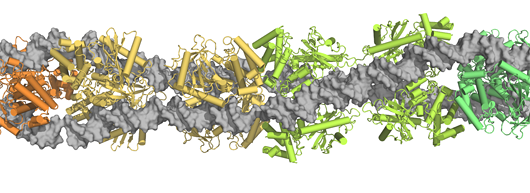New RTG1721 Publication: Innate Immunity
To operate, insert dimers
13.09.2017
The presence of DNA in mammalian cell cytoplasm triggers an immune response by binding to a dimeric enzyme, which inserts between DNA double helices to form the “rungs” of a ladder-like structure, as an LMU team has now shown.

Complex consisting of cGAS dimers and cytosolic DNA. (K.-P. Hopfner, LMU)
In higher organisms, the genetic material is normally confined to the cell nucleus and the membrane-bounded organelles known as mitochondria. Any DNA found in the cytoplasm that surrounds these compartments must therefore originate either from damage to the nucleus or mitochondria, or from invasive bacterial pathogens or DNA viruses. The enzyme cGAS acts as a sensor of such misplaced DNA and “informs” the cell’s innate immune system of the presence of an infection. Now the research group led by Prof. Karl-Peter Hopfner, in collaboration with his colleague Prof. Veit Hornung and Prof. Heinrich Leonhardt of the LMU Biomedical Center, has discovered why the length of the cytoplasmic DNA has an impact on the efficiency with which it is detected. The researchers found that the DNA and the enzyme interact to form a ladder-like complex, and went on to demonstrate that this structure must exceed a certain length in order to activate the innate immune system. The new findings appear in the leading journal Nature.
More information please visit LMU.de/news
Original Publication:
cGAS senses long and HMGB/TFAM-bound U-turn DNA by forming protein-DNA ladders.
Andreeva L, Hiller B, Kostrewa D, Lässig C, de Oliveira Mann CC, Jan Drexler D, Maiser A, Gaidt M, Leonhardt H, Hornung V, Hopfner KP.
Nature. 2017 Sep 21;549(7672):394-398. doi: 10.1038/nature23890. Epub 2017 Sep 13. PubMed

